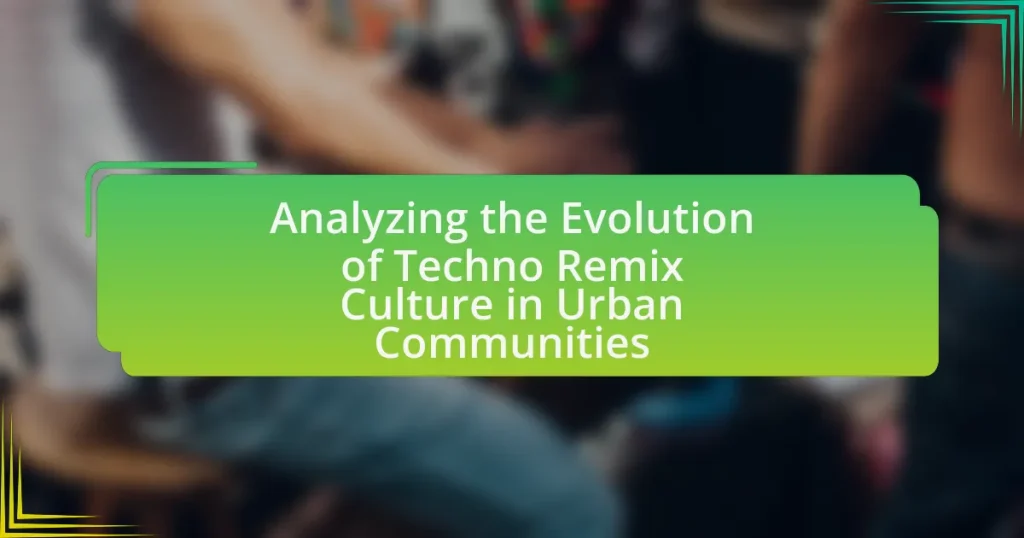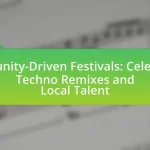Techno remix culture in urban communities is defined by the reinterpretation and recontextualization of techno music through sampling, remixing, and collaborative creation. Originating in cities like Detroit and Berlin during the 1980s and 1990s, this culture has evolved significantly, influenced by technological advancements and socio-economic dynamics. Key characteristics include creativity, collaboration, and the transformative use of technology, which foster community engagement and cultural expression. The article explores the historical context, the impact of urban environments, the role of digital tools, and the challenges faced by artists, while also examining future prospects and best practices for supporting this vibrant cultural phenomenon.
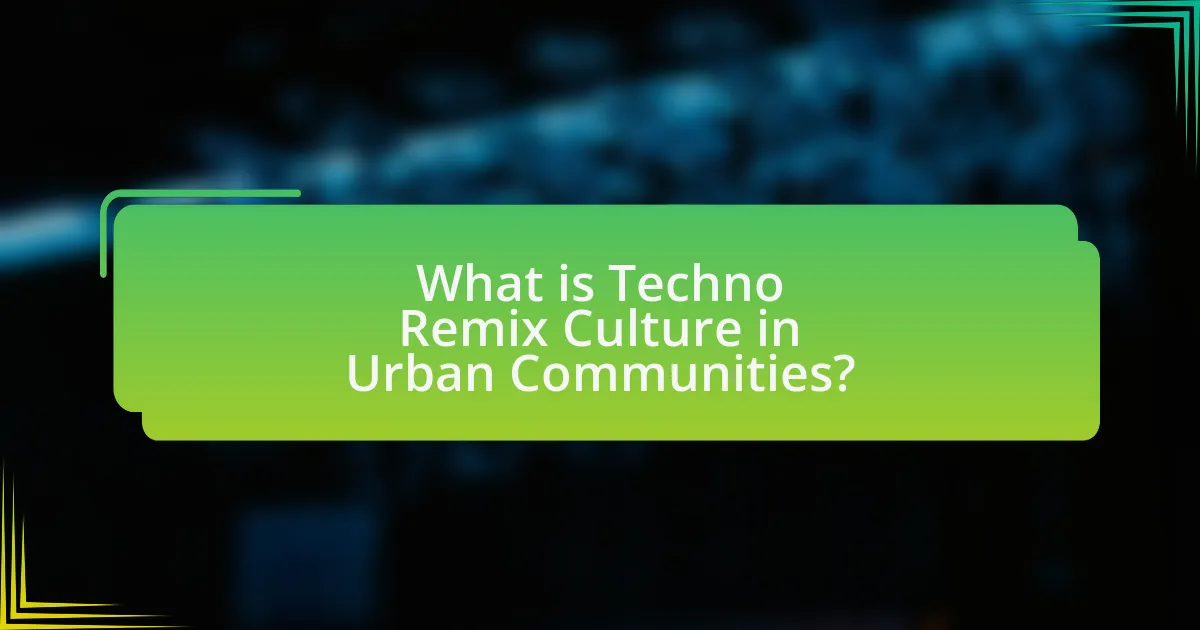
What is Techno Remix Culture in Urban Communities?
Techno remix culture in urban communities refers to the practice of reinterpreting and recontextualizing techno music through sampling, remixing, and collaborative creation. This culture thrives in urban settings where diverse musical influences converge, allowing artists to blend traditional techno elements with local sounds and styles. For instance, cities like Berlin and Detroit have been pivotal in shaping this culture, as they are known for their vibrant electronic music scenes and community-driven events. The proliferation of digital tools and platforms has further facilitated this remix culture, enabling artists to share their work widely and engage with audiences globally.
How did Techno Remix Culture originate in urban settings?
Techno Remix Culture originated in urban settings as a response to the socio-economic and cultural dynamics of cities, particularly in the 1980s and 1990s. Urban areas, characterized by diverse populations and vibrant nightlife, provided fertile ground for the emergence of electronic music genres, including techno. The genre was heavily influenced by the technological advancements in music production and the accessibility of synthesizers and drum machines, which allowed artists to experiment and create new sounds.
Cities like Detroit, where techno was born, served as hubs for innovation, with local clubs and warehouses becoming venues for DJs to remix and reinterpret tracks, fostering a communal atmosphere. The underground scene thrived on the blending of various musical styles, including house, funk, and disco, leading to the development of a distinct remix culture. This culture was further propelled by the rise of rave parties and the DIY ethic prevalent in urban youth communities, emphasizing creativity and self-expression through music.
What historical events influenced the rise of Techno Remix Culture?
The rise of Techno Remix Culture was significantly influenced by the emergence of electronic music in the late 1970s and early 1980s, particularly in cities like Detroit and Chicago. The development of affordable synthesizers and drum machines, such as the Roland TR-808, allowed artists to experiment with new sounds and create innovative music. Additionally, the cultural movements surrounding disco, punk, and hip-hop provided a backdrop for remixing and reinterpreting existing tracks, fostering a creative environment for DJs and producers. The establishment of rave culture in the late 1980s and early 1990s further propelled the remix culture, as underground parties became spaces for sharing and transforming music. These historical events collectively laid the groundwork for the Techno Remix Culture, characterized by its emphasis on collaboration, innovation, and the blending of genres.
How have urban environments shaped the development of this culture?
Urban environments have significantly shaped the development of techno remix culture by providing diverse spaces for creativity and collaboration. In cities, the concentration of artists, musicians, and cultural innovators fosters an environment where experimentation with sound and technology thrives. For instance, the emergence of underground clubs and raves in urban settings during the late 1980s and early 1990s facilitated the sharing of ideas and techniques among DJs and producers, leading to the evolution of unique remix styles. Additionally, urban areas often have access to advanced technology and resources, enabling artists to produce and distribute their work more effectively. This dynamic interplay between urban infrastructure and cultural expression has been crucial in establishing techno remix culture as a prominent and evolving art form.
What are the key characteristics of Techno Remix Culture?
Techno Remix Culture is characterized by its emphasis on creativity, collaboration, and the transformative use of technology in music production. This culture thrives on the remixing of existing tracks, allowing artists to reinterpret and innovate upon original works, which fosters a sense of community among producers and DJs. The culture also embraces the use of digital tools and software, enabling rapid production and distribution of remixes, which has democratized music creation. Additionally, the culture is marked by live performances and DJ sets that often blend various genres, creating a dynamic and immersive experience for audiences. The rise of platforms like SoundCloud and Bandcamp has further facilitated the sharing and discovery of remixes, reinforcing the collaborative spirit inherent in Techno Remix Culture.
How does the remixing process define this culture?
The remixing process defines techno culture by emphasizing creativity, collaboration, and the reinterpretation of existing musical works. This culture thrives on the ability to take original tracks and transform them into new expressions, allowing artists and fans to engage in a shared experience of innovation. The act of remixing not only showcases individual artistic skills but also fosters a sense of community, as artists often collaborate and share their remixes within urban environments. Historical examples, such as the rise of Detroit techno in the 1980s, illustrate how remixing became a vehicle for cultural expression and social commentary, reflecting the socio-political landscape of the time.
What role do community and collaboration play in Techno Remix Culture?
Community and collaboration are fundamental to Techno Remix Culture, as they foster creativity and innovation among artists and fans. This culture thrives on shared experiences, where individuals come together to remix and reinterpret existing tracks, leading to a dynamic exchange of ideas and styles. Collaborative efforts often result in unique soundscapes that reflect the collective identity of urban communities, enhancing the genre’s evolution. For instance, events like collaborative DJ sets and remix competitions encourage participation and engagement, reinforcing social bonds and collective ownership of the music. This interconnectedness not only amplifies the reach of techno music but also solidifies its role as a communal art form, deeply rooted in the cultural fabric of urban environments.
Why is Techno Remix Culture significant in urban communities?
Techno Remix Culture is significant in urban communities because it serves as a form of artistic expression and social cohesion. This culture allows individuals to reinterpret and recontextualize existing music, fostering creativity and collaboration among diverse groups. For instance, in cities like Detroit, where techno originated, remixing has been a means for marginalized voices to gain visibility and influence within the music scene. Furthermore, studies indicate that participation in remix culture can enhance community engagement and identity, as seen in events like local music festivals that celebrate these remixes, drawing in thousands of attendees and promoting local talent.
How does it contribute to cultural identity and expression?
Techno remix culture contributes to cultural identity and expression by serving as a platform for diverse voices and experiences within urban communities. This genre allows individuals to reinterpret and blend various musical influences, reflecting their unique cultural backgrounds and social realities. For instance, the incorporation of local sounds and rhythms into techno remixes can highlight specific cultural narratives, fostering a sense of belonging and community identity. Additionally, events and gatherings centered around techno music often promote inclusivity and collaboration, further enhancing cultural expression through shared experiences.
What impact does it have on local economies and social dynamics?
The impact of techno remix culture on local economies and social dynamics is significant, as it fosters economic growth through increased tourism, local business support, and job creation. Events centered around techno music attract visitors, leading to higher spending in hospitality, retail, and entertainment sectors. For instance, cities like Berlin have seen a boost in their economies, with nightlife contributing approximately 1.5 billion euros annually. Socially, techno remix culture promotes community cohesion and cultural exchange, as diverse groups come together to share experiences and creativity. This cultural interaction can lead to enhanced social networks and a sense of belonging among participants, further enriching the urban social fabric.
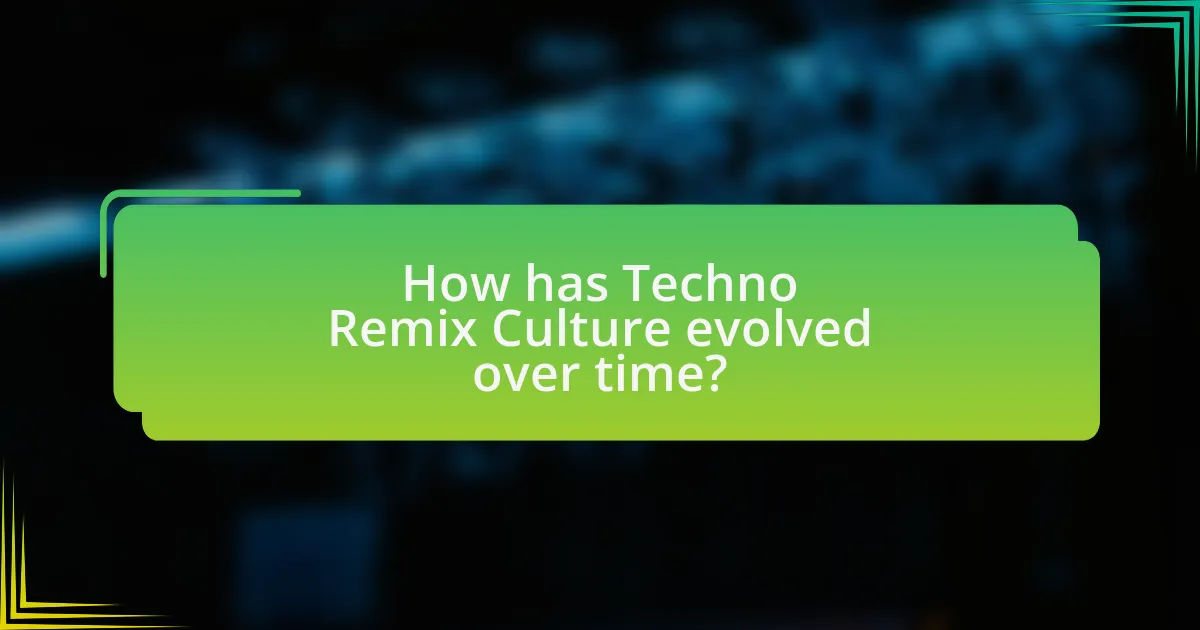
How has Techno Remix Culture evolved over time?
Techno remix culture has evolved significantly from its origins in the 1980s, transitioning from underground scenes to mainstream acceptance. Initially, techno music was characterized by its experimental sounds and was primarily produced by artists in Detroit, such as Juan Atkins and Derrick May, who utilized synthesizers and drum machines to create innovative tracks. As the genre gained popularity, particularly in Europe during the 1990s, remixing became a common practice, allowing DJs and producers to reinterpret existing tracks, thus expanding the genre’s reach and diversity.
The rise of digital technology in the 2000s further transformed techno remix culture, enabling easier access to production tools and distribution platforms. This democratization led to an explosion of remixes and sub-genres, with artists like Deadmau5 and Skrillex pushing the boundaries of sound and style. Additionally, the advent of social media and streaming services facilitated the sharing of remixes, allowing for a global audience and fostering collaborations across different musical genres.
By the 2010s, techno remix culture had integrated into various urban communities, influencing not only music but also fashion, art, and lifestyle. Events like festivals and club nights became platforms for showcasing remixes, solidifying their role in the cultural landscape. The evolution of techno remix culture reflects broader trends in technology, globalization, and community engagement, demonstrating its dynamic nature and enduring relevance in contemporary music.
What technological advancements have influenced its evolution?
Technological advancements such as digital audio workstations (DAWs), sampling technology, and the internet have significantly influenced the evolution of techno remix culture in urban communities. DAWs like Ableton Live and FL Studio have democratized music production, allowing artists to create and manipulate sounds with ease. Sampling technology has enabled the incorporation of diverse musical elements, fostering creativity and innovation in remixes. Additionally, the internet has facilitated global collaboration and distribution, allowing artists to share their work and reach wider audiences, which has been crucial for the growth of techno remix culture.
How have digital tools changed the way remixes are created and shared?
Digital tools have significantly transformed the creation and sharing of remixes by providing accessible software and platforms that facilitate collaboration and distribution. Software such as Ableton Live and FL Studio allows artists to manipulate audio tracks easily, enabling more intricate and innovative remixing techniques. Additionally, platforms like SoundCloud and Bandcamp have democratized the sharing process, allowing creators to reach global audiences without traditional gatekeeping. This shift has led to an explosion of diverse remix styles and a more vibrant community, as evidenced by the rise of user-generated content and the proliferation of remix competitions online.
What role do social media platforms play in the dissemination of Techno remixes?
Social media platforms serve as crucial channels for the dissemination of Techno remixes by enabling artists to share their work widely and engage with audiences directly. These platforms, such as SoundCloud, Instagram, and YouTube, allow creators to upload and promote their remixes, reaching global audiences instantly. For instance, SoundCloud reports that over 175 million monthly listeners engage with music content, facilitating the rapid spread of Techno remixes among diverse listener demographics. Additionally, social media algorithms promote trending tracks, further amplifying the visibility of popular remixes. This interconnectedness fosters community engagement, allowing fans to share, comment, and collaborate, which enhances the remix culture within urban communities.
How have cultural shifts affected Techno Remix Culture?
Cultural shifts have significantly influenced Techno Remix Culture by altering its themes, accessibility, and community engagement. For instance, the rise of digital technology and social media has democratized music production, allowing a broader range of artists to participate in remixing, which has led to a diversification of sounds and styles within the genre. Additionally, the increasing emphasis on inclusivity and representation in music has prompted remix culture to embrace a wider array of cultural influences, reflecting the multicultural dynamics of urban communities. This evolution is evidenced by the proliferation of online platforms where artists share their remixes, such as SoundCloud and Bandcamp, which have seen millions of uploads, showcasing the impact of cultural shifts on the accessibility and collaborative nature of Techno Remix Culture.
What changes in societal attitudes have influenced the acceptance of remix culture?
Societal attitudes have shifted towards greater acceptance of remix culture due to the increasing recognition of creativity as a collaborative process. This change is evidenced by the rise of digital platforms that facilitate sharing and remixing, such as YouTube and SoundCloud, which have democratized content creation. Additionally, legal reforms, like the introduction of Creative Commons licenses, have encouraged the use of existing works while respecting original creators. The growing appreciation for diversity in artistic expression has also contributed, as communities increasingly value innovation and reinterpretation over strict originality. These factors collectively illustrate a significant transformation in how society views and engages with remix culture.
How have global influences reshaped local Techno scenes?
Global influences have significantly reshaped local Techno scenes by introducing diverse sounds, styles, and cultural elements from various regions. For instance, the integration of Afrobeat rhythms and Latin percussion into Techno has created hybrid genres that resonate with local audiences while maintaining a global appeal. This blending is evident in cities like Berlin, where international artists frequently collaborate with local DJs, fostering a cross-pollination of ideas and techniques. Additionally, the rise of digital platforms has enabled local artists to access global trends and audiences, further enhancing the local scene’s dynamism. The impact of global festivals and events, such as Movement in Detroit, also plays a crucial role in connecting local scenes to the broader Techno community, allowing for the exchange of cultural practices and musical innovations.
What challenges does Techno Remix Culture face today?
Techno Remix Culture faces significant challenges today, primarily due to issues of commercialization and copyright infringement. The rise of digital platforms has led to widespread access to music, but it has also resulted in artists struggling to monetize their work effectively. According to a 2021 report by the International Federation of the Phonographic Industry, streaming services account for over 60% of global recorded music revenue, yet many remix artists receive minimal compensation due to complex licensing agreements. Additionally, the proliferation of unauthorized remixes can dilute the original artist’s brand and lead to legal disputes, further complicating the landscape for creators within the techno genre.
How do issues of copyright and intellectual property impact remix artists?
Issues of copyright and intellectual property significantly impact remix artists by limiting their ability to use existing works without permission, which can hinder creativity and innovation. Copyright laws protect original works, meaning that remix artists must navigate complex licensing agreements to legally incorporate samples or elements from other artists’ music. For instance, the U.S. Copyright Act requires that any use of copyrighted material must be authorized by the rights holder, which can lead to costly fees or legal disputes. Additionally, the rise of digital platforms has made it easier for artists to share their remixes, but it has also increased the scrutiny of copyright infringement, as seen in cases like the lawsuit against DJ Z-Trip for unauthorized use of samples. This legal landscape creates a challenging environment for remix artists, often forcing them to either seek permission or create original content, which can stifle the remix culture that thrives on reinterpretation and collaboration.
What are the implications of commercialization on the authenticity of the culture?
Commercialization significantly undermines the authenticity of culture by prioritizing profit over genuine expression. As cultural elements become commodified, they often lose their original meanings and contexts, transforming into products designed for mass consumption rather than authentic representation. For instance, in the techno remix culture, the commercialization of music festivals has led to a focus on mainstream appeal, often sidelining underground artists and authentic sounds that originally defined the genre. This shift can dilute the cultural significance and community ties that are essential to the authenticity of the culture, as seen in the rise of corporate sponsorships that prioritize brand visibility over artistic integrity.
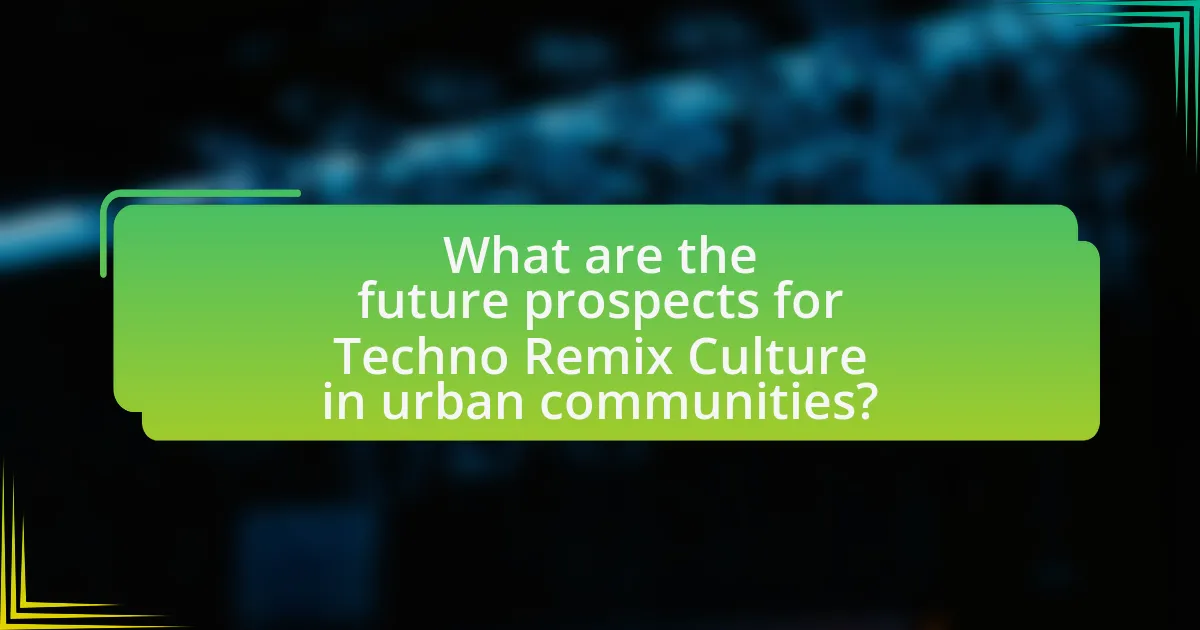
What are the future prospects for Techno Remix Culture in urban communities?
The future prospects for Techno Remix Culture in urban communities are promising, driven by technological advancements and increasing accessibility to music production tools. As digital platforms continue to evolve, they facilitate collaboration and distribution, allowing artists from diverse backgrounds to create and share remixes easily. The rise of social media and streaming services has also expanded audiences, enabling local artists to gain global recognition. Furthermore, urban communities are increasingly embracing cultural diversity, which fosters innovation in remixing practices. This cultural exchange enhances the richness of the Techno Remix Culture, making it more dynamic and relevant.
How can emerging artists navigate the evolving landscape of Techno Remix Culture?
Emerging artists can navigate the evolving landscape of Techno Remix Culture by actively engaging with digital platforms and collaborating with established artists. Digital platforms like SoundCloud and Bandcamp allow artists to share their remixes and original tracks, reaching a global audience. Collaborating with established artists not only enhances visibility but also provides mentorship opportunities, which can be crucial for skill development.
Furthermore, understanding the legal aspects of remixing, such as copyright laws and licensing, is essential for protecting their work and ensuring fair use. According to a study by the University of Southern California, artists who leverage social media for promotion see a 30% increase in audience engagement, highlighting the importance of online presence in today’s music landscape. By combining these strategies, emerging artists can effectively position themselves within the Techno Remix Culture.
What strategies can artists use to maintain authenticity while reaching wider audiences?
Artists can maintain authenticity while reaching wider audiences by staying true to their unique sound and cultural roots. This involves incorporating personal experiences and local influences into their music, which resonates with both niche and broader audiences. For instance, artists like Derrick May and Juan Atkins, pioneers of techno, drew heavily from their Detroit upbringing, blending local musical styles with innovative production techniques. Additionally, engaging directly with fans through social media and live performances allows artists to cultivate a loyal following while sharing their authentic voice. This strategy has been validated by studies showing that artists who maintain a strong connection to their origins often enjoy sustained success in diverse markets.
How can collaboration within communities foster innovation in remix culture?
Collaboration within communities fosters innovation in remix culture by enabling diverse perspectives and skills to converge, leading to unique creative outputs. When individuals from various backgrounds work together, they share ideas, techniques, and resources, which enhances the creative process. For instance, community-driven projects often result in innovative remixes that blend different musical styles, as seen in urban areas where local artists collaborate to create new genres. This collaborative environment not only encourages experimentation but also builds a sense of ownership and investment in the creative work, further driving innovation. Studies have shown that collaborative networks in creative fields can significantly increase the rate of innovation, as evidenced by the rise of collaborative platforms like SoundCloud, where artists share and remix each other’s work, leading to a vibrant ecosystem of creativity.
What role will technology play in the future of Techno Remix Culture?
Technology will play a pivotal role in shaping the future of Techno Remix Culture by enhancing accessibility, creativity, and collaboration among artists and fans. Advancements in digital audio workstations, AI-driven music production tools, and online platforms for sharing and remixing music will democratize the creation process, allowing a broader range of individuals to participate in the culture. For instance, software like Ableton Live and platforms such as SoundCloud have already transformed how music is produced and distributed, enabling rapid sharing and collaboration across global networks. This trend is expected to continue, fostering innovation and diversity within the genre as more creators leverage technology to express their artistic visions.
How might advancements in AI and machine learning influence remixing techniques?
Advancements in AI and machine learning will significantly enhance remixing techniques by automating complex audio processing tasks and enabling real-time analysis of musical elements. These technologies can analyze vast amounts of data from existing tracks to identify patterns, styles, and structures, allowing artists to create innovative remixes that blend various genres seamlessly. For instance, AI algorithms can generate unique soundscapes or suggest chord progressions based on the analysis of popular tracks, thereby expanding the creative possibilities for remix artists. Additionally, machine learning models can learn from user preferences and adapt to individual styles, making the remixing process more personalized and efficient. This shift towards data-driven creativity is evidenced by tools like LANDR and iZotope, which utilize AI to assist in mastering and sound design, demonstrating the practical application of these advancements in the music industry.
What potential does virtual reality hold for immersive remix experiences?
Virtual reality holds significant potential for immersive remix experiences by enabling users to interact with and manipulate digital environments in real-time. This technology allows for the creation of multi-sensory experiences where users can remix audio, visuals, and spatial elements, enhancing creativity and engagement. For instance, platforms like Oculus and HTC Vive have demonstrated how VR can facilitate collaborative remixing, allowing multiple users to contribute to a shared virtual space, thus fostering community and collaboration in urban techno culture. Studies indicate that immersive environments can increase user engagement by up to 70%, highlighting the effectiveness of VR in transforming traditional remix practices into dynamic, participatory experiences.
What best practices can urban communities adopt to support Techno Remix Culture?
Urban communities can adopt inclusive policies and create collaborative spaces to support Techno Remix Culture. By establishing community centers that host workshops and events, urban areas can foster creativity and collaboration among artists and enthusiasts. Research indicates that cities with vibrant cultural hubs, such as Berlin, have successfully nurtured remix culture by providing accessible venues and resources for artists to experiment and share their work. Additionally, promoting local talent through festivals and partnerships with educational institutions can enhance community engagement and innovation in the techno scene.
How can local governments and organizations promote inclusive spaces for remix culture?
Local governments and organizations can promote inclusive spaces for remix culture by providing accessible venues, funding community-driven projects, and fostering collaboration among diverse groups. Accessible venues ensure that all community members can participate in remix activities, while funding initiatives like workshops and events encourages creativity and innovation. Collaboration among artists, technologists, and local residents enhances the richness of remix culture, as seen in successful programs like the “Remix Culture Initiative” in various urban areas, which have demonstrated increased community engagement and cultural exchange.
What initiatives can be implemented to educate and engage new artists in the community?
To educate and engage new artists in the community, initiatives such as mentorship programs, workshops, and collaborative projects can be implemented. Mentorship programs connect emerging artists with experienced professionals, providing guidance and industry insights that are crucial for artistic development. Workshops focused on specific skills, such as music production, sound design, and remixing techniques, can enhance technical abilities and foster creativity. Collaborative projects encourage artists to work together, promoting networking and the sharing of diverse perspectives, which is essential in the evolving landscape of techno remix culture. These initiatives not only build skills but also create a supportive community that nurtures artistic growth and innovation.
